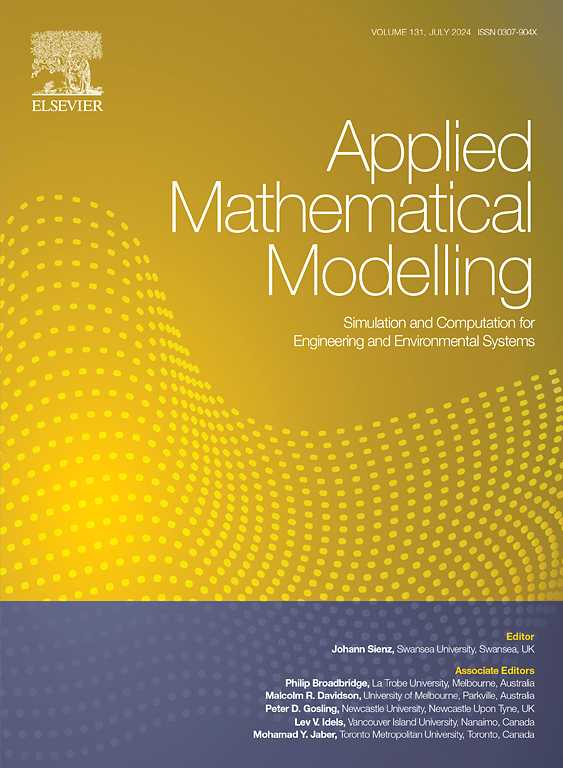Research on impact vibration of cantilever fluid-conveying pipe with foundation excitation and gap constraint
IF 4.4
2区 工程技术
Q1 ENGINEERING, MULTIDISCIPLINARY
引用次数: 0
Abstract
In practical engineering, the unilateral gap constraint impact vibration in fluid-conveying pipes is a critical concern, often arising from constraint loosening or the presence of barriers around the pipe. These factors can significantly affect the service life and safety reliability of the pipes. A tension and compression anisotropy spring with rapidly increasing restoring force in compression but almost zero restoring force in tension is proposed to simulate the unilateral gap constraint, model a fluid-conveying pipe with a Pfluger column. Its reliability is also verified based on the bifurcation phase diagram comparison between the small and large stiffness conditions. Subsequently, we establish a vibration mechanics analysis model for the cantilever fluid-conveying pipe under foundation excitation to assess the effects of basic excitation frequency, fluid velocity, distributed follower force, position coordinate of unilateral gap constraint, and the viscoelastic coefficient on the impact vibration stability of the fluid-conveying pipe. Our findings reveal that when the period-doubling bifurcation sequence is interrupted by Bare-grazing bifurcation, the system directly transitions into chaotic vibration or induces a new period-doubling bifurcation sequence, followed by re-entry into chaotic vibration. These results provide valuable insights into the intricate dynamics of fluid-conveying pipes under foundation excitation, offering a deeper understanding of the impact of various parameters on the pipe's vibration.
基础激励和间隙约束下悬臂输液管道冲击振动研究
在实际工程中,流体输送管道的单边间隙约束冲击振动是一个关键问题,通常是由于约束松动或管道周围存在障碍物引起的。这些因素会显著影响管道的使用寿命和安全可靠性。提出了一种压缩恢复力迅速增大而拉伸恢复力几乎为零的拉压各向异性弹簧,用于模拟单向间隙约束,建立了带Pfluger柱的输液管道模型。通过小刚度和大刚度条件下的分岔相图对比,验证了其可靠性。随后,建立了基础激励下悬臂式输液管道的振动力学分析模型,评估了基本激励频率、流体速度、分布从动力、单边间隙约束位置坐标、粘弹性系数对输液管道冲击振动稳定性的影响。研究结果表明,当双周期分岔序列被裸放牧分岔中断时,系统直接进入混沌振动或诱导一个新的双周期分岔序列,然后重新进入混沌振动;这些结果为研究基础激励下流体输送管道的复杂动力学提供了有价值的见解,使人们更深入地了解各种参数对管道振动的影响。
本文章由计算机程序翻译,如有差异,请以英文原文为准。
求助全文
约1分钟内获得全文
求助全文
来源期刊

Applied Mathematical Modelling
数学-工程:综合
CiteScore
9.80
自引率
8.00%
发文量
508
审稿时长
43 days
期刊介绍:
Applied Mathematical Modelling focuses on research related to the mathematical modelling of engineering and environmental processes, manufacturing, and industrial systems. A significant emerging area of research activity involves multiphysics processes, and contributions in this area are particularly encouraged.
This influential publication covers a wide spectrum of subjects including heat transfer, fluid mechanics, CFD, and transport phenomena; solid mechanics and mechanics of metals; electromagnets and MHD; reliability modelling and system optimization; finite volume, finite element, and boundary element procedures; modelling of inventory, industrial, manufacturing and logistics systems for viable decision making; civil engineering systems and structures; mineral and energy resources; relevant software engineering issues associated with CAD and CAE; and materials and metallurgical engineering.
Applied Mathematical Modelling is primarily interested in papers developing increased insights into real-world problems through novel mathematical modelling, novel applications or a combination of these. Papers employing existing numerical techniques must demonstrate sufficient novelty in the solution of practical problems. Papers on fuzzy logic in decision-making or purely financial mathematics are normally not considered. Research on fractional differential equations, bifurcation, and numerical methods needs to include practical examples. Population dynamics must solve realistic scenarios. Papers in the area of logistics and business modelling should demonstrate meaningful managerial insight. Submissions with no real-world application will not be considered.
 求助内容:
求助内容: 应助结果提醒方式:
应助结果提醒方式:


